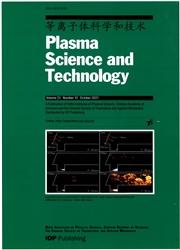射频感应阴极的数值模拟与性能分析
IF 1.8
3区 物理与天体物理
Q3 PHYSICS, FLUIDS & PLASMAS
引用次数: 1
摘要
射频(RF)感应阴极作为霍尔推进器和离子推进器的主要电子源和中和器,在任务周期长、速度增量大、响应速度快的航天任务中具有广阔的应用前景。本文提出了一个综合考虑射频电磁场、提取电子的静电场、流场、等离子体输运和电化学反应过程的多物理场射频感应阴极模型。上述每一个物理场都可以形成一个封闭的偏微分方程。采用二维有限元程序COMSOL求解多物理场模型。该模型展示了阳极斑点的形成过程,在实践中验证了非双极流动理论。仿真结果表明,射频感应阴极中的电流跳变是由阳极斑点引起的。此外,研究了射频功率、偏置电压、驱动气体流量等预设放电参数以及线圈结构、放电室尺寸、离子集电极面积、发射孔尺寸、阳极靶与发射孔距离等结构参数对阴极性能的影响,并提出了一些重要的优化参数。本文章由计算机程序翻译,如有差异,请以英文原文为准。
Numerical simulation and performance analysis of the radiofrequency inductive cathode
Abstract The radiofrequency (RF) inductive cathode has great prospects in space missions with long mission cycles, large speed increments, and rapid response requirements as the main electron source and neutralizer in Hall thrusters and ion thrusters. This paper proposes a comprehensive multi-physics RF inductive cathode model in which the RF electromagnetic field, electrostatic field for extracting electrons, flow field, plasma transport and electrochemical reaction process are all accounted for. Each physical field mentioned above can form a closed partial differential equation. The two-dimensional finite element code COMSOL is used to solve the multi-physics model. With this model, the formation process of the anode spot is exhibited and demonstrates the non-bipolar flow theory in practice. The simulation results demonstrate that the current jump in the RF inductive cathode is caused by the anode spot. Furthermore, the influences of preset discharge parameters such as RF power, bias voltage and actuating gas flow as well as structural parameters like the coil structure, discharge chamber size and ion collector area, emission hole size, distance between the anode target and the emission hole etc on the cathode performance are investigated, and some important optimal parameters are proposed.
求助全文
通过发布文献求助,成功后即可免费获取论文全文。
去求助
来源期刊

Plasma Science & Technology
物理-物理:流体与等离子体
CiteScore
3.10
自引率
11.80%
发文量
3773
审稿时长
3.8 months
期刊介绍:
PST assists in advancing plasma science and technology by reporting important, novel, helpful and thought-provoking progress in this strongly multidisciplinary and interdisciplinary field, in a timely manner.
A Publication of the Institute of Plasma Physics, Chinese Academy of Sciences and the Chinese Society of Theoretical and Applied Mechanics.
 求助内容:
求助内容: 应助结果提醒方式:
应助结果提醒方式:


